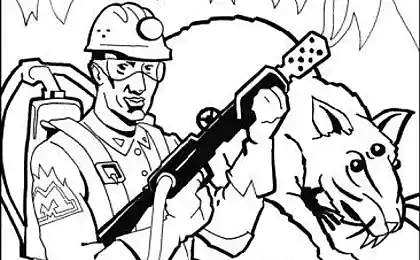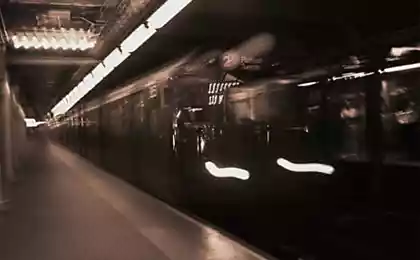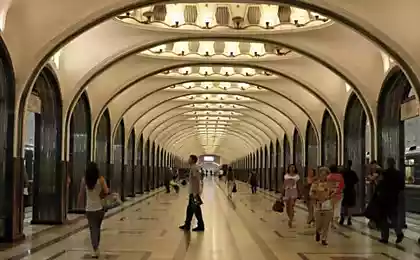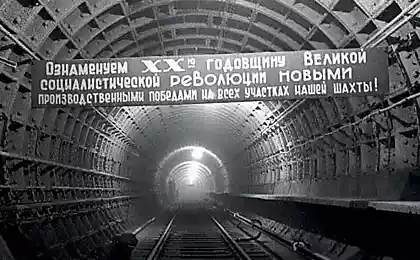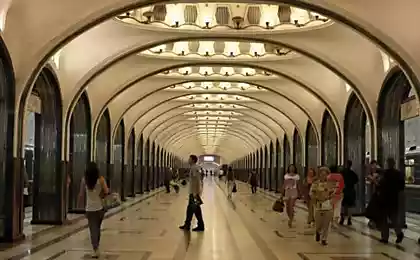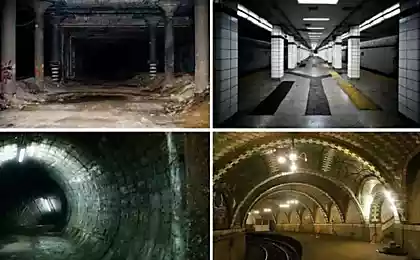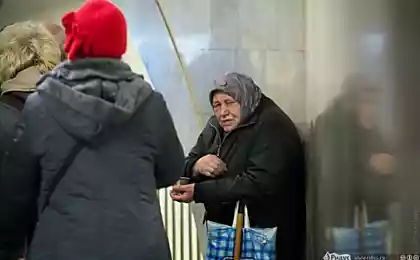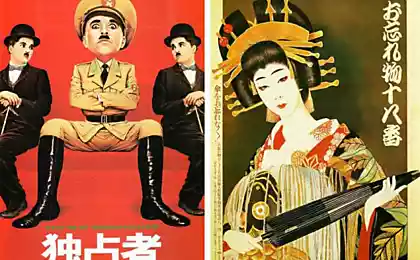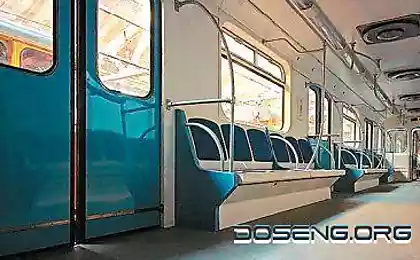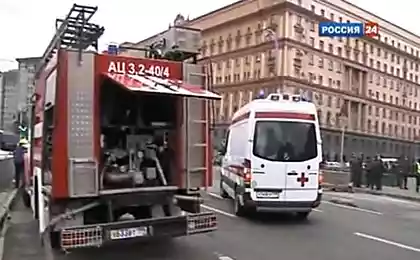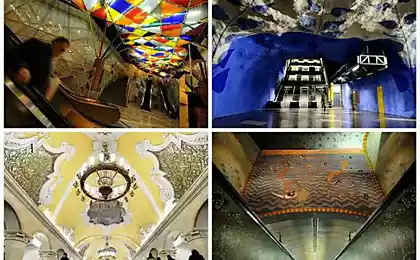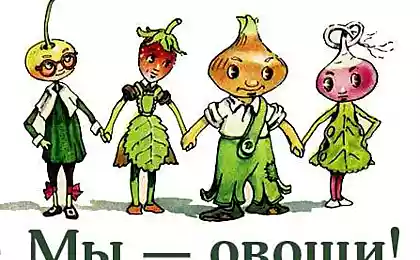1210
Secrets of the Moscow Metro
A secret location in the Moscow metro were already before his birth in 1935. The project was the second phase of the station "Sovetskaya" under Soviet Square. between the stations "Theater" (in those days, "Sverdlov Square") and "Mayakovskaya". Under construction on the personal order of Stalin "Soviet" adapted for underground control station of the Moscow headquarters of GO. Arising from the closure of its unreasonably long haul in the center of Moscow was eliminated only 07/15/1979 construction of "Gorky" - "Tver". The project cost is very expensive, even at times of stagnation. If you look carefully at the stage before the "Tverskaya", you can see traces of the "Soviet".
The next was a pre-war (as well as the post-war) modernization project "Pokrovskaya" to connect the Kremlin with both Stalin bunkers. Before the war, Stalin was planning to build the biggest stadium is not only expected the Olympics. Ha idea of the stadium of the USSR (or the people) it prompted a massive promotional activities are often carried out by the Nazis in Germany and the German people so loved the Fuhrer. Under the future of the stadium (a piece of which is still built) was built for Stalin's bunker with little room for performances and the tunnel to the stands. There were built two road tunnel: the Kremlin (and the gate of the tunnel is located just below the Spassky Gate) and near the metro station "Sokolniki". There is a transition from "Izmailovsky Park" to the bunker. Middle way to the station, in addition to the planned large passenger traffic, carrying a function spetsputi Stalin during the celebration. Note the graceful light bulbs illuminating the middle path. They are not in extreme ways. The same Stalin's bunker was built under his dacha in Kuntsevo (there is also road tunnel on the public reception of the Defense Ministry on Butcher, 37 by the Kremlin). About him known only to specialists MOE: it is located directly above the center of the Central Regional Office. On Stalin's suspiciousness known. From the first days of the war he hesitated, his stay in the capital or leave with the government to Kuibyshev (now Samara).
When frequent bombings in Moscow, he ordered the construction of a bomb shelter, which is dug in Kuntsevo at a depth of fifteen meters. In order to fully protect the leader, as the slabs used iron rails. According to the Ministry of Emergency Situations Colonel Sergei Cherepanov, construction and today stand a direct hit by an aircraft bomb. Entrance to the bunker - the usual door, which meet any entrance door, with combination lock. Very clean staircase with a handrail leads to the ground. Full feeling that go down into the basement of an ordinary house. Stalin did not go up the stairs. Especially for him was put into the elevator, where laid parquet, walls sheathed with wood paneling. Elevator put together a bomb shelter with Stalin's dacha, under which the bunker was dug. To prevent accidental meeting of Joseph Stalin with the staff, it was built a few corridors. In the corridor to technician, cooks and other walls covered with white tiles. Stalin also walked from the elevator on the parquet floor and surveyed the marble walls. The bomb shelter Josef Stalin conducted the meeting of the Defense Council. For this he was allotted a spacious office - "The General." Its walls are decorated with oak and Karelian birch. In the middle - an oval oak table. Against the wall - tables duty officers and stenographers. With the war in the shelter survived vosmirozhkovye chandeliers. Only rectangular modern fluorescent lights remind us that the yard is not 1942. A small corridor separated from the courtroom bedroom leader. The bedroom is very small. It placed a bed and a nightstand. Because of this, the bunker and was launched 04/05/1953 mysterious land deep foundations "Revolution Square" - "Kiev". Stalin feared a repetition of the case of a hit bomb in the tunnel ceiling on the stretch between the "Smolensk" and "Arbat". The site was built in record time, less than two years, despite the fact that the track was held in extremely adverse hydrological conditions. The first had to solve the problem of pairing two tunnels radius - existing and new, non-stop normal movement. For this tunnel built larger diameter that instead of acting as if the tunnel. Tunnel for the "Kiev" was passed and then right up to the Victory Park. According to the plan in 1932 in line Kuntsevo Krylatskoye and had to be completely underground. And she had to take place close to the dacha of Stalin. When building a new express line to "Kuntsevo" This tunnel was used. This explains such a strange choice of route.
For the first time about the Kremlin's evacuation metrotonnel going far beyond Moscow, I heard in 81-82 years from his uncle - an electronics, then working in one of the "boxes" connected to the computer for the army. The information is printed in the brain and has been one of the reasons for my love of the underground shastanyu. The first serious information about these metrotonneli appeared in '92 in one of the rooms "AIF". There's some aunt wrote that her friend worked as a cleaner in the KGB and its sensitive sites were taken to special subway lines. "AIF" gave the answer that the system described in the annual publication of the Ministry of Defense of the Soviet Armed Forces for 1991. Weekly published a simplified map and a list of lines of '91 (see. Above).
So, Metro-2
Line 1
Put into operation in 1967 (presumably that some part was started earlier). The length of 27 km. Stations:
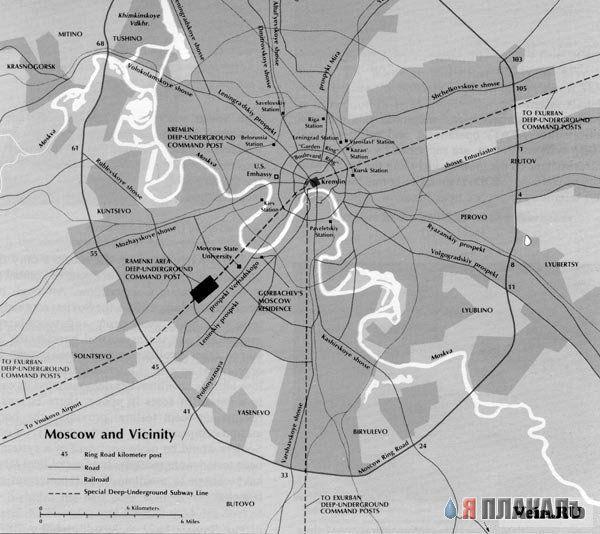
Kremlin
Library named after Lenin (to evacuate the underground city in Ramenki all readers who are at signal "Atom" in the halls, maybe Kremlin Station and Library - is one and the same station)
Yellow house with a turret on Smolenskaya Square project academician ZHOLTOVSKOGO (this is a special house, and include 2 subway system: Filevskiy line and Metro-2, because of the lifts at the metro station-2 in the house went to the legend of such stations a little Do not under every house in Moscow nomenklatura)
the former residence of the first and last President of the USSR on the Lenin Hills
underground city under Ramenka (maks.vmestimost 12 000-15 000 inhabitants) with a pedestrian tunnel to the main building of Moscow State University (entrance at the PPC Zone B)
Academy of the Federal Security Service and the Institute of Cryptography, Telecommunications and Computer Science of the Russian FSB (huge brick building at the entrance to the Olympic Village. In one of the rare open gate leaves in the building can be seen stretching far down the long corridor, illuminated by small lamps on each side)
Academy of the General Staff
emergency exit somewhere in Solntsevo
the government's Vnukovo-2 airport
In the book "Moscow Metro" in 1954 described a fifth of all subway construction. If Shcherbakovskaya (now Riga) radius all clear that the continuation of the Frunze radius baffled. Described never realized version of a tunnel under the Moscow River. The length of 6, 5 km away. "Frunze" is the plan in the same place now. "Usachevsky" or was "Sports," or should have been closer to the Grand Pirogov. "Luzhniki" was supposed to be at the entrance to the stadium in Luzhniki on Hovoluzhnetskom. Hazemnye lobbies "Lenin Hills" were planned on the slopes of the mountains and the Sparrow from Vorobyevsky highway (ul.Kosygina). "University" is planned next to the main building of Moscow State University.
In 1957 and 1959 all built differently.
There is a fishy tale that a youth festival in 1957 constructed a branch of the "Park of Culture" to "University". In the spirit of making Khrushchev about reducing the cost of construction of the designers decided to pave the route of the passenger on the already constructed at the time the subway tunnel-2 of the first line. It would seem that there is a ready tunnel dug under the Moscow River, so no need to spend time and money to build a new crossing over the water hazard. But at the last moment "competent authorities" firmly said no! And I had to flog a fever, changing the project, taking a new route towards the underground metro bridge and constructing the station "Lenin Hills." The memory of that old "hitch" was the characteristic curve of the line near the station Metro "Sports" and die now wonder bridge, which was built in a hurry to violations of building technology. Frankly, I'm in this story is not particularly believe, but a few things make you think, perhaps, some truth in all of this is.
Initially the "University" wanted to build next to the MSU. But because the first line of Metro-2 is just under the CP passes, more precisely, 3 basement levels, or 3, where there are cryogenic installations for the generation of liquid nitrogen to freeze the ground. Sign in with PPC Zone B of the main building. By the way, in the first basement almost exactly under the PPC Zone B has a door with a combination lock and a television camera.
According to the US DIA (Defence Intelligence Agency), Metro station-2 of the first line is at the former residence of the first and last President of the USSR (Gorbachev) in the Lenin Hills, and this is exactly the place where it was planned station "Lenin Mountains."
Rather, projects have been developed tunnels and stations of deep foundations. Then Khrushchev ordered to sharply reduce the cost of construction. Then a miracle was built a bridge in which the salt is greater than concrete. And with the rise of a bend after the "Sport" appeared. But in the 60s, when the hopper in Kuntsevo and the first line of Metro-2 were built, while the old projects and raised. What sense to duplicate the work? And leisurely zababahali tunnel under the old projects, but single track.
If you go from the "Sports" to "university" to the left on the course after the "Sports" can be seen at the beginning stage, connecting the path where you are coming from the opposite. Then you can branch to the left of the train. Officially, it's working a dead end, but it goes further down between the major tunnels under the river and along the arc steeply to one side. Contact rail in the tunnel terminates. The tunnel eventually rests on the steel gate. This is the only gate usual subway and Metro-2 in Moscow.
When planning the construction of the temple in honor of the victory in the Patriotic War of 1812, there were several projects, one of them - to build a temple on the Sparrow Hills. Construction has not begun, because there very poor soils that are not able to withstand the large building. But they could not make the royal architects did Stalin. When built the main building of Moscow State University, then dug a huge pit for the foundation, filled with liquid nitrogen, then we put a refrigeration unit for the place which later became known as the 3rd basement floor or -3. This area was declared a super secret, as in the case of a possible sabotage and damaging freezers a week building splyvet into the Moscow River. In charge of the 3rd basement 15 KGB. It is this level of MSU is connected to the underground city in Ramenki and Metro Station-2.
In Tpopapevckom lecopapke for the Academy of General Staff, you can see the subway ventilation shafts. Academy of the General Staff itself - it is a stpoenie CENTRAL building and side vokpug. If smotpet from the street, then they 5 floors, and actually much more. Elevator goes underground for a few more. Downstairs there is a lot of very hoposho ohpanyaemyh places where almost no one can enter. From SOME sources has been stretched, it is access to the Metro-2.
When there was no "Pr. Vernadsky, "on the spot" Salute "was grandly rugged terrain: ravines, a cascade of ponds and a river. The 68-70 is all neatly filled with plenty of soil taken, probably, from the construction of the first line and the underground city in Ramenki.
If you draw a line from the "Southwest" in Ochakovo and lay about 500 meters, we get to a place where there was something like a concrete little factory with a lift to the top of the wheel. Every morning, down down uymischa terrible people. All lasted up to 79 years.
The main construction base of the first line - that notorious concrete small factory south of Moscow State University. That's where imported materials and exported the land.
There are indications that the first line in 1986-87 lengthened. There are two interesting places of Moscow. This military town Vlasikha (aka Odintsovo-10). There's a 58-64 team built complex RVSN 4 bunk bunker and residence of their commander. In 1986-87 we built a new 12-tiered tank two kilometers from the old. The rails have seen down there for sure. There is a place Golitsyno-2, MCC-military space forces. Interestingly enough - the entrance to the bunker in small houses, such as residential. Is there one in the town square, which is a monument - an ancient radar, there's the whole is. People who work there, it is known that this is where a branch runs to the Vnukovo-2.
Heposredstvenno in the Odintsovo in 1987 started to build a residential district "new home" for construction of Metro-2. The station is there too.
Line 2
Cdana early '87. Length 60 km (it turns out that the world record for metrotonnelyam). It starts from the Kremlin, then south parallel to the Warsaw highway through seen in the government's pension "Bor" (ibid alternate command post of the General Staff).
Ha line have preserved the station, which is the most mysterious transition from "Tretyakov" Kalinin line.
It is likely that the line should be extended to the new bunker Raven (about 74 kilometers south of the Kremlin). There are inaccurate information that the line is somewhere for Chekhov. Vacationers from Alachkovo talk about the local military camp, they have underground facility that is 30 stories underground leaves, they said to have been on such a doctrine: it is necessary in the great hall (the size of a witness could not say, but he says "just great"), a simple composition of the subway it is ignited and then quenched. Living in Kryukovo (that Chekhov) sometimes wake up at night from the fact that beneath the train passes. Vacationers in Vidnoe say that in the early '80s there have something to dig very deep. Remember only a few places pit large and deep, but the wall of boards or something there still have been strengthened, and the pits were one after the other, well, that is on the same line.
Construction of the second line base is somewhere in Tsaritsyno.
Line 3
Cdana too, at the beginning of '87. The length of 25 km. It starts from the Kremlin, then the Lubyanka (maybe there is a station at the Grand Theatre, t. To. From the fountain in pl.Teatralnoy could get into the subway tunnel-2), the headquarters of the Moscow Military District Air Defense on Butcher, 33 (located next to the public reception of the Defense Ministry on Butcher, 37, which in turn has a road tunnel to Stalin's dacha in Kuntsevo. During the war, the station "Kirov" are sections of the General Staff and Air Defence "Schnick. Trains were not stopped, the platform fenced off from the paths of high plywood wall . After the war a long time to destroy the traces of this activity. Under the station, and building on the Butcher, 33, built a new tank of Staff Air Defence) and CCU air defense (and in the same General Staff Air Force and Air Defense) in the village of Zarya Balashikha district, where there is a military town with 20 000 inhabitants.
The line runs parallel to the highway enthusiasts and in Izmailovo Park. Most likely, the station is next to the "Red Gate" (this is questionable, but the huge Stalin's bunker there just is - with lyuchnym access to the platform, "Red Gate").
The people working in the bunker n. Dawn is called "mole". And yet - the "miners". Every day they go in an inconspicuous-looking little house brick and high-speed elevators descend to a depth of 122 meters. Last checking of documents, with a small submachine next column border, the massive iron doors, collapsing automatically at the first sign of danger - and our heroes find themselves in one of the most secret military facilities of Russia. This underground city - the Central Command Post (TCP) of the air defense forces, the inner sanctum of our defense power. To get here can not be even the first state officials and important foreign guests. For any trips you need permission private defense minister. Bury our party ordered the military in 1958. All of the General Staff and the NBI began urgently to transfer in the near suburbs. The "cold war" at any moment could turn into a nuclear war, and the first bombing of the capital could leave the army without "eyes", "ears" and "language". To avoid this, they decided to bury the most valuable and powerful even from bunkers to lead troops. The underground city was built in Stakhanov: in the 61 th year of the first "moles" celebrated the housewarming. For this thanks to Marshal of the Soviet Union Pavel Batitsky and metrostroevtsy - that they were invited to perform the important task of the motherland. The city-hopper provides everything to survive the end of the world: its own power plants, fire extinguishing systems, water and air purification, drainage, food stocks. They say there is even a place where you can comfortably and white lingerie sleep. Even women who work here, especially in the conditions do not complain. Transport problems in the "city" built on 1,100 people, also achieved. The hotel staff four elevators - two passenger and two cargo.
Line 4
Information about it is almost fictional. The Russian budget in 1997 laid the sum of its construction.
Source:
The next was a pre-war (as well as the post-war) modernization project "Pokrovskaya" to connect the Kremlin with both Stalin bunkers. Before the war, Stalin was planning to build the biggest stadium is not only expected the Olympics. Ha idea of the stadium of the USSR (or the people) it prompted a massive promotional activities are often carried out by the Nazis in Germany and the German people so loved the Fuhrer. Under the future of the stadium (a piece of which is still built) was built for Stalin's bunker with little room for performances and the tunnel to the stands. There were built two road tunnel: the Kremlin (and the gate of the tunnel is located just below the Spassky Gate) and near the metro station "Sokolniki". There is a transition from "Izmailovsky Park" to the bunker. Middle way to the station, in addition to the planned large passenger traffic, carrying a function spetsputi Stalin during the celebration. Note the graceful light bulbs illuminating the middle path. They are not in extreme ways. The same Stalin's bunker was built under his dacha in Kuntsevo (there is also road tunnel on the public reception of the Defense Ministry on Butcher, 37 by the Kremlin). About him known only to specialists MOE: it is located directly above the center of the Central Regional Office. On Stalin's suspiciousness known. From the first days of the war he hesitated, his stay in the capital or leave with the government to Kuibyshev (now Samara).
When frequent bombings in Moscow, he ordered the construction of a bomb shelter, which is dug in Kuntsevo at a depth of fifteen meters. In order to fully protect the leader, as the slabs used iron rails. According to the Ministry of Emergency Situations Colonel Sergei Cherepanov, construction and today stand a direct hit by an aircraft bomb. Entrance to the bunker - the usual door, which meet any entrance door, with combination lock. Very clean staircase with a handrail leads to the ground. Full feeling that go down into the basement of an ordinary house. Stalin did not go up the stairs. Especially for him was put into the elevator, where laid parquet, walls sheathed with wood paneling. Elevator put together a bomb shelter with Stalin's dacha, under which the bunker was dug. To prevent accidental meeting of Joseph Stalin with the staff, it was built a few corridors. In the corridor to technician, cooks and other walls covered with white tiles. Stalin also walked from the elevator on the parquet floor and surveyed the marble walls. The bomb shelter Josef Stalin conducted the meeting of the Defense Council. For this he was allotted a spacious office - "The General." Its walls are decorated with oak and Karelian birch. In the middle - an oval oak table. Against the wall - tables duty officers and stenographers. With the war in the shelter survived vosmirozhkovye chandeliers. Only rectangular modern fluorescent lights remind us that the yard is not 1942. A small corridor separated from the courtroom bedroom leader. The bedroom is very small. It placed a bed and a nightstand. Because of this, the bunker and was launched 04/05/1953 mysterious land deep foundations "Revolution Square" - "Kiev". Stalin feared a repetition of the case of a hit bomb in the tunnel ceiling on the stretch between the "Smolensk" and "Arbat". The site was built in record time, less than two years, despite the fact that the track was held in extremely adverse hydrological conditions. The first had to solve the problem of pairing two tunnels radius - existing and new, non-stop normal movement. For this tunnel built larger diameter that instead of acting as if the tunnel. Tunnel for the "Kiev" was passed and then right up to the Victory Park. According to the plan in 1932 in line Kuntsevo Krylatskoye and had to be completely underground. And she had to take place close to the dacha of Stalin. When building a new express line to "Kuntsevo" This tunnel was used. This explains such a strange choice of route.
For the first time about the Kremlin's evacuation metrotonnel going far beyond Moscow, I heard in 81-82 years from his uncle - an electronics, then working in one of the "boxes" connected to the computer for the army. The information is printed in the brain and has been one of the reasons for my love of the underground shastanyu. The first serious information about these metrotonneli appeared in '92 in one of the rooms "AIF". There's some aunt wrote that her friend worked as a cleaner in the KGB and its sensitive sites were taken to special subway lines. "AIF" gave the answer that the system described in the annual publication of the Ministry of Defense of the Soviet Armed Forces for 1991. Weekly published a simplified map and a list of lines of '91 (see. Above).
So, Metro-2
Line 1
Put into operation in 1967 (presumably that some part was started earlier). The length of 27 km. Stations:

Kremlin
Library named after Lenin (to evacuate the underground city in Ramenki all readers who are at signal "Atom" in the halls, maybe Kremlin Station and Library - is one and the same station)
Yellow house with a turret on Smolenskaya Square project academician ZHOLTOVSKOGO (this is a special house, and include 2 subway system: Filevskiy line and Metro-2, because of the lifts at the metro station-2 in the house went to the legend of such stations a little Do not under every house in Moscow nomenklatura)
the former residence of the first and last President of the USSR on the Lenin Hills
underground city under Ramenka (maks.vmestimost 12 000-15 000 inhabitants) with a pedestrian tunnel to the main building of Moscow State University (entrance at the PPC Zone B)
Academy of the Federal Security Service and the Institute of Cryptography, Telecommunications and Computer Science of the Russian FSB (huge brick building at the entrance to the Olympic Village. In one of the rare open gate leaves in the building can be seen stretching far down the long corridor, illuminated by small lamps on each side)
Academy of the General Staff
emergency exit somewhere in Solntsevo
the government's Vnukovo-2 airport
In the book "Moscow Metro" in 1954 described a fifth of all subway construction. If Shcherbakovskaya (now Riga) radius all clear that the continuation of the Frunze radius baffled. Described never realized version of a tunnel under the Moscow River. The length of 6, 5 km away. "Frunze" is the plan in the same place now. "Usachevsky" or was "Sports," or should have been closer to the Grand Pirogov. "Luzhniki" was supposed to be at the entrance to the stadium in Luzhniki on Hovoluzhnetskom. Hazemnye lobbies "Lenin Hills" were planned on the slopes of the mountains and the Sparrow from Vorobyevsky highway (ul.Kosygina). "University" is planned next to the main building of Moscow State University.
In 1957 and 1959 all built differently.
There is a fishy tale that a youth festival in 1957 constructed a branch of the "Park of Culture" to "University". In the spirit of making Khrushchev about reducing the cost of construction of the designers decided to pave the route of the passenger on the already constructed at the time the subway tunnel-2 of the first line. It would seem that there is a ready tunnel dug under the Moscow River, so no need to spend time and money to build a new crossing over the water hazard. But at the last moment "competent authorities" firmly said no! And I had to flog a fever, changing the project, taking a new route towards the underground metro bridge and constructing the station "Lenin Hills." The memory of that old "hitch" was the characteristic curve of the line near the station Metro "Sports" and die now wonder bridge, which was built in a hurry to violations of building technology. Frankly, I'm in this story is not particularly believe, but a few things make you think, perhaps, some truth in all of this is.
Initially the "University" wanted to build next to the MSU. But because the first line of Metro-2 is just under the CP passes, more precisely, 3 basement levels, or 3, where there are cryogenic installations for the generation of liquid nitrogen to freeze the ground. Sign in with PPC Zone B of the main building. By the way, in the first basement almost exactly under the PPC Zone B has a door with a combination lock and a television camera.
According to the US DIA (Defence Intelligence Agency), Metro station-2 of the first line is at the former residence of the first and last President of the USSR (Gorbachev) in the Lenin Hills, and this is exactly the place where it was planned station "Lenin Mountains."
Rather, projects have been developed tunnels and stations of deep foundations. Then Khrushchev ordered to sharply reduce the cost of construction. Then a miracle was built a bridge in which the salt is greater than concrete. And with the rise of a bend after the "Sport" appeared. But in the 60s, when the hopper in Kuntsevo and the first line of Metro-2 were built, while the old projects and raised. What sense to duplicate the work? And leisurely zababahali tunnel under the old projects, but single track.
If you go from the "Sports" to "university" to the left on the course after the "Sports" can be seen at the beginning stage, connecting the path where you are coming from the opposite. Then you can branch to the left of the train. Officially, it's working a dead end, but it goes further down between the major tunnels under the river and along the arc steeply to one side. Contact rail in the tunnel terminates. The tunnel eventually rests on the steel gate. This is the only gate usual subway and Metro-2 in Moscow.
When planning the construction of the temple in honor of the victory in the Patriotic War of 1812, there were several projects, one of them - to build a temple on the Sparrow Hills. Construction has not begun, because there very poor soils that are not able to withstand the large building. But they could not make the royal architects did Stalin. When built the main building of Moscow State University, then dug a huge pit for the foundation, filled with liquid nitrogen, then we put a refrigeration unit for the place which later became known as the 3rd basement floor or -3. This area was declared a super secret, as in the case of a possible sabotage and damaging freezers a week building splyvet into the Moscow River. In charge of the 3rd basement 15 KGB. It is this level of MSU is connected to the underground city in Ramenki and Metro Station-2.
In Tpopapevckom lecopapke for the Academy of General Staff, you can see the subway ventilation shafts. Academy of the General Staff itself - it is a stpoenie CENTRAL building and side vokpug. If smotpet from the street, then they 5 floors, and actually much more. Elevator goes underground for a few more. Downstairs there is a lot of very hoposho ohpanyaemyh places where almost no one can enter. From SOME sources has been stretched, it is access to the Metro-2.
When there was no "Pr. Vernadsky, "on the spot" Salute "was grandly rugged terrain: ravines, a cascade of ponds and a river. The 68-70 is all neatly filled with plenty of soil taken, probably, from the construction of the first line and the underground city in Ramenki.
If you draw a line from the "Southwest" in Ochakovo and lay about 500 meters, we get to a place where there was something like a concrete little factory with a lift to the top of the wheel. Every morning, down down uymischa terrible people. All lasted up to 79 years.
The main construction base of the first line - that notorious concrete small factory south of Moscow State University. That's where imported materials and exported the land.
There are indications that the first line in 1986-87 lengthened. There are two interesting places of Moscow. This military town Vlasikha (aka Odintsovo-10). There's a 58-64 team built complex RVSN 4 bunk bunker and residence of their commander. In 1986-87 we built a new 12-tiered tank two kilometers from the old. The rails have seen down there for sure. There is a place Golitsyno-2, MCC-military space forces. Interestingly enough - the entrance to the bunker in small houses, such as residential. Is there one in the town square, which is a monument - an ancient radar, there's the whole is. People who work there, it is known that this is where a branch runs to the Vnukovo-2.
Heposredstvenno in the Odintsovo in 1987 started to build a residential district "new home" for construction of Metro-2. The station is there too.
Line 2
Cdana early '87. Length 60 km (it turns out that the world record for metrotonnelyam). It starts from the Kremlin, then south parallel to the Warsaw highway through seen in the government's pension "Bor" (ibid alternate command post of the General Staff).
Ha line have preserved the station, which is the most mysterious transition from "Tretyakov" Kalinin line.
It is likely that the line should be extended to the new bunker Raven (about 74 kilometers south of the Kremlin). There are inaccurate information that the line is somewhere for Chekhov. Vacationers from Alachkovo talk about the local military camp, they have underground facility that is 30 stories underground leaves, they said to have been on such a doctrine: it is necessary in the great hall (the size of a witness could not say, but he says "just great"), a simple composition of the subway it is ignited and then quenched. Living in Kryukovo (that Chekhov) sometimes wake up at night from the fact that beneath the train passes. Vacationers in Vidnoe say that in the early '80s there have something to dig very deep. Remember only a few places pit large and deep, but the wall of boards or something there still have been strengthened, and the pits were one after the other, well, that is on the same line.
Construction of the second line base is somewhere in Tsaritsyno.
Line 3
Cdana too, at the beginning of '87. The length of 25 km. It starts from the Kremlin, then the Lubyanka (maybe there is a station at the Grand Theatre, t. To. From the fountain in pl.Teatralnoy could get into the subway tunnel-2), the headquarters of the Moscow Military District Air Defense on Butcher, 33 (located next to the public reception of the Defense Ministry on Butcher, 37, which in turn has a road tunnel to Stalin's dacha in Kuntsevo. During the war, the station "Kirov" are sections of the General Staff and Air Defence "Schnick. Trains were not stopped, the platform fenced off from the paths of high plywood wall . After the war a long time to destroy the traces of this activity. Under the station, and building on the Butcher, 33, built a new tank of Staff Air Defence) and CCU air defense (and in the same General Staff Air Force and Air Defense) in the village of Zarya Balashikha district, where there is a military town with 20 000 inhabitants.
The line runs parallel to the highway enthusiasts and in Izmailovo Park. Most likely, the station is next to the "Red Gate" (this is questionable, but the huge Stalin's bunker there just is - with lyuchnym access to the platform, "Red Gate").
The people working in the bunker n. Dawn is called "mole". And yet - the "miners". Every day they go in an inconspicuous-looking little house brick and high-speed elevators descend to a depth of 122 meters. Last checking of documents, with a small submachine next column border, the massive iron doors, collapsing automatically at the first sign of danger - and our heroes find themselves in one of the most secret military facilities of Russia. This underground city - the Central Command Post (TCP) of the air defense forces, the inner sanctum of our defense power. To get here can not be even the first state officials and important foreign guests. For any trips you need permission private defense minister. Bury our party ordered the military in 1958. All of the General Staff and the NBI began urgently to transfer in the near suburbs. The "cold war" at any moment could turn into a nuclear war, and the first bombing of the capital could leave the army without "eyes", "ears" and "language". To avoid this, they decided to bury the most valuable and powerful even from bunkers to lead troops. The underground city was built in Stakhanov: in the 61 th year of the first "moles" celebrated the housewarming. For this thanks to Marshal of the Soviet Union Pavel Batitsky and metrostroevtsy - that they were invited to perform the important task of the motherland. The city-hopper provides everything to survive the end of the world: its own power plants, fire extinguishing systems, water and air purification, drainage, food stocks. They say there is even a place where you can comfortably and white lingerie sleep. Even women who work here, especially in the conditions do not complain. Transport problems in the "city" built on 1,100 people, also achieved. The hotel staff four elevators - two passenger and two cargo.
Line 4
Information about it is almost fictional. The Russian budget in 1997 laid the sum of its construction.
Source:
